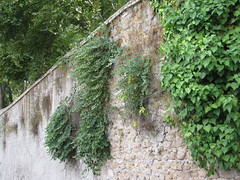- Back to basics: Considerations in evaluating the outcomes of community forestry. You don’t need fancy indicators.
- Plant exploitation of the last foragers at Shizitan in the Middle Yellow River Valley China: Evidence from grinding stones. Remains of starch and patterns of wear on grinding stones show that Paleolithic people in China used a lot of plants, in a lot of ways.
- Phenotypic diversity and identification of wild Arachis accessions with useful agronomic and nutritional traits. Our friends at ICRISAT identify the top 20 wild peanut accessions.
- Taxonomy and genetic diversity of domesticated Capsicum species in the Andean region. AFLPs and SSRs clarify some taxonomic issues, but show high diversity not just in Bolivia, the putative centre of origin. No top 20 though.
- From forest to field: Perennial fruit crop domestication. They’re like annuals in some respects, different in others. Perhaps most interestingly, their domestication bottleneck wasn’t so much of one.
- Allelopathic potential of Triticum spp., Secale spp. and Triticosecale spp. and use of chromosome substitutions and translocations to improve weed suppression ability in winter wheat. Low in wheat, but high in some rye accessions, and transferrable.
- Genotyping and evaluation of local olive varieties of a climatically disfavoured region through molecular, morphological and oil quality parameters. Eight minor varieties could be less so.
Rupestrine Roman agrobiodiversity
Capparis on this occasion. But I’ve also seen figs, pomegranate and assorted crop wild relatives growing on walls. Time for a serious survey?
Nibbles: Refugia, Mann, Tree pix, Sparing v sharing, Lethal yellowing, Value chains, Coral sun-blocking, GlobalHort, Gravenstein, Pirate agrobiodiversity
- How species survive climate change.
- Charles C. Mann, author of great books on pre-Columbian America and the consequences of the Columbian Exchange, interviewed.
- Dreamy pictures of old British trees.
- “Protecting wild species may require growing more food on less land.” Great press release headlines of our times. Fortunately Mongabay has a discussion.
- Coconut lethal yellowing wreaking havoc in Mozambique.
- What makes a good food value chain?
- Boffins want to re-activate coral genes in temperate plants to stop them getting sunstroke. Or something.
- Old friend engaged by GlobalHort to work on position paper on “Promoting Agrobiodiversity for International Development: A Rationale and Roadmap for Collective Action”. Go, Hannah.
- Grapes vs apples in Sonoma County.
- Aaargh, pirates smoked like chimneys and drank like fish. Well I never. Anyway, nice to see them making full use of the local agrobiodiversity products.
Brainfood: Roots, Ethnopharmacology, Heat tolerance, Food origin myths, Trees outside forests, Wild fruit tree agroforestry, Viruses in genebank, Reintroduction
- Breeding crop plants with deep roots: their role in sustainable carbon, nutrient and water sequestration. Good for soil structure, good for C sequestration, good for yields. What’s not to like?
- Ethnopharmacology, food production, nutrition and biodiversity conservation: Towards a sustainable future for indigenous peoples. Ethnopharmacologists need to think more generally about nutrition, and a lot more about conservation. And a view on the whole “wonder herb” thing from two botanical garden boffins who protest way too much as far as I’m concerned.
- Modelling predicts that heat stress, not drought, will increase vulnerability of wheat in Europe. It’s the heat, not the humidity. But maybe wild relatives can help.
- The Virtuous Manioc and the Horny Barbasco: Sublime and Grotesque Modes of Transformation in the Origin of Yanesha Plant Life. Maize is the result of a virgin birth, chili peppers of a fart. I’ll buy that.
- Is there a forest transition outside forests? Trajectories of farm trees and effects on ecosystem services in an agricultural landscape in Eastern Germany. Yes, but.
- Biodiversity and socioeconomic factors supporting farmers’ choice of wild edible trees in the agroforestry systems of Benin (West Africa). Those factors are: how important the trees are for food and medicine and how accessible they are. Still no cure for cancer. Anyway, here’s what ICRAF thinks should come next: domestication, natch.
- Pome fruit viruses at the Canadian Clonal Genebank and molecular characterization of Apple chlorotic leaf spot virus isolates. There’s a lot of them. Well that can’t be good, can it?
- A long-term view of rare plant reintroduction. A previous review is way too pessimistic.
Taking tomato improvement to the masses
It’s basically your standard I-found-redemption-in-a-tomato-heirloom story:
Another life somewhere in the pastoral wilds of Co Kilkenny, in a summer long ago, the wife of a Finnish jewellerymaker brought slices of tomato to the lunch table: slices a centimetre thick, a hand’s breadth across, jewel-bright with olive oil and scattered with chopped green basil. This simple revelation of what tomatoes should be, enfolded in mouthfuls of sweetness and scent, set my early hankering for the good life.
But this piece in the Irish Times did teach me something for a change. It taught me there’s something called the EU-Sol project “to improve the quality of the tomatoes and potatoes we eat.” But there’s more to it than that: check out the bits of its website aimed at the general public and schools.
